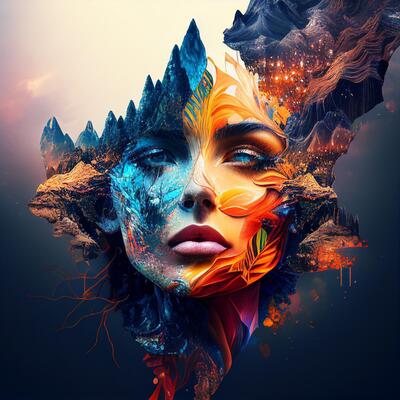Delving Into the Diverse Globe of Artistic Expression: From Surrealism to Abstract Realistic Look
In the realm of creative expression, from the dreamlike landscapes of surrealism to the detailed play of light and type in abstract realism, artists have constantly pressed the borders of creative thinking and creative imagination. Each motion holds an one-of-a-kind lens whereby the globe is seen and analyzed, offering a peek right into the midsts of human emotion, assumption, and assumed. As we explore the diverse world of art, we are presented with a tapestry of styles, strategies, and viewpoints that test our understanding and provoke contemplation. The trip through these diverse kinds of creative expression promises to unwind an abundant tapestry of aesthetic narration and intellectual questions that mesmerizes the mind and stirs the spirit.
Surrealism: Letting Loose the Subconscious
Surrealism, an avant-garde artistic activity of the 20th century, dug right into the depths of the subconscious, introducing a globe of dream-like images and unusual juxtapositions. Spearheaded by musicians like Salvador Dali, René Magritte, and Joan Miró, Surrealism sought to challenge the traditional means of understanding and seeing art. With strategies such as automatism and desire evaluation, Surrealist musicians aimed to use the subconscious mind to disclose hidden realities and needs.
Among the crucial elements of Surrealism was the focus on the illogical and the incredible. By integrating unexpected components in their jobs, Surrealist artists aimed to produce a sense of disorientation and shock in the audience. This disruption of reasoning and factor was suggested to provoke a much deeper expedition of the subconscious and the enigmas of the human mind.
Abstract Realistic Look: Redefining Perception
Challenging traditional creative borders, Abstract Realism redefines perception through the fusion of well-known aspects with abstract forms. This ingenious strategy to art integrates the representational precision of realism with the creative freedom of abstraction, providing viewers a special aesthetic experience that triggers them to question their understanding of reality.
In Abstract Realism, musicians make every effort to capture the significance of their topics while additionally instilling their collaborate with a feeling of deepness and complexity via abstract aspects. By blending the accustomed to the unfamiliar, these artists invite target markets to engage with their items on several levels, encouraging them to discover the subtleties of structure, color, and form.

Cubism: Fragmentizing Truth
Using geometric kinds and fragmented perspectives, Cubism transformed the imaginative representation of fact in the very early 20th century. This method not just deconstructed fact but additionally stressed the flatness of the canvas, leading the method for future abstract art movements.

Cubism can be categorized right into 2 main phases: Analytical Cubism, identified by monochromatic color pattern and elaborate, fragmented kinds; and Synthetic Cubism, which included collection elements and brighter colors right into the compositions. Through these distinct stages, Cubism affected not only paint however likewise sculpture, design, and design. trump art. Its influence resounded across the art globe, motivating artists to check out brand-new methods of standing for the globe and translating around them
Expressionism: Feelings on Canvas
Checking out the depths of human emotions with vibrant and meaningful brushstrokes, Expressionism emerged as an extensive artistic activity in the very early 20th century. Unlike previous art motions that concentrated on showing the external globe, Expressionism dove into the interior realm of the artist's mind, aiming to evoke raw feelings and provoke natural actions from visitors.
Expressionist musicians, such as Edvard Munch, Egon Schiele, and Emil Nolde, declined traditional notions of beauty and realistic look in support of distorting form and color to convey subjective feelings. Making use of overstated brushwork, strong colors, and distorted numbers helped produce a sense of anxiousness, alienation, or interest in their works.
Among one of the most popular instances of Expressionism is Munch's "The Scream," which records the extreme stress and anxiety and despair of modern life through its swirling, altered number against a blood-red skies. Via their emotionally billed works, Expressionist artists looked for to challenge standard imaginative norms and offer a window into the unstable midsts of the human spirit.
Contemporary Art: Advancing Viewpoints

Among the defining characteristics of contemporary art is its consistent evolution and capability to adapt to transforming social landscapes. Artists are increasingly integrating innovation right into their practice, blurring the lines in between the physical and electronic realms. This fusion of mediums enables innovative methods of storytelling and engaging with audiences in a much more interactive fashion.
Moreover, modern art typically acts as a system for social discourse, dealing with pushing issues such as identification, national politics, and the setting. Musicians are using their work to trigger crucial discussions why not try this out and prompt thought, dropping light on the intricacies of the world we live in. As point of views remain to evolve, contemporary art continues to be a significant and vibrant pressure in forming our social landscape.
Final Thought
Finally, the world of creative expression encompasses a wide variety of styles and activities, each with its own special strategy to communicating significance and emotion. From surrealism's exploration of the subconscious to abstract realism's redefining of assumption, and from cubism's fragmentation of fact to expressionism's portrayal of emotions, art remains to advance and challenge point of views - trump art. Contemporary art shows the ever-changing globe we stay in, providing new ways to interpret and comprehend the intricacies of our reality
As we discover the complex world of art, we are provided with a tapestry of designs, techniques, and viewpoints that challenge our understanding and prompt contemplation. Its effect resounded across the art globe, inspiring artists to check out new means of standing for the world and analyzing around them.
